Charles Brooking is a fascinating and knowledgeable collector of architectural detail, The Brooking Collection of Architectural Detail, and as Surveyors we find his lifelong quest to collect British building details unique, informative and valuable and a collection that must be kept intact for years to come. If you need help and advice with regard to building surveys, structural surveys, structural reports, engineers reports, specific defects report, dilapidations or any other property matters please free phone 0800 298 5424.
The following is one of a series of interviews with Charles Brooking, Historic and Listed Buildings Detail Expert, The Brooking Collection of Architectural Detail and a Surveyor where we have recorded his comments and various aspects that have affected windows and doors and other collectibles. The interviews outline how his collection started and built over the years and gives an insight into the amazing architectural features housed in his fine collection.
Surveyor: Please tell us about your first solo rescue of architectural detail?
Charles Brooking : It was the summer of 1968 and this was quite an important demolition, back to the old hunting ground and as my father used to say not Sydenham Road again? They were all named after doctors, these roads hence the name Sydenham and Jenner Road and because it was laid out by Henry Peak, and there was originally I think South Street and Sydenham Road .
In the summer of 1968 all of those houses that had been closed up in Bright Hill, Hill Place were then empty. They were built between around about 1861 to 1898. Hill Place was built as a piece in 1876. The houses were built with Bargate Stone with red brick quoins around the windows. They were very narrow houses, up a steep hill, staggered rather like a sort of Coronation Street if you like. They had used interestingly drainage pipes for chimney pots, salt glazed drainage pipes, rather than proper chimney pots. Whereas Bright Hill was more interesting, it was a mixture of 1860's very flat simple houses, flat fronted terraced houses with more Georgian type windows which were six over six and then you had three over three's, an 1980's intervention by Henry Peak possibly.
Rescue defined
Charles Brooking defines a rescue as saving a window or door or staircase that would be doomed.
Charles Brooking was a pioneer in the rescue of architectural detailing as many years ago it was very much considered a strange and an unusual past time to want to rescue old parts of buildings with everything new and shiny being so important.
Surveyor: Do you always give the number of panes of glass from the top panel first and then in the bottom when you say three over three?
Charles Brooking : Yes you do yes. Then opposite was another mixture of some buildings built in Bargate stone some brick, some were set back from the road and some with little shops. Two were set way back, which were built about 1860, with lovely margin light sashes the demolition started.
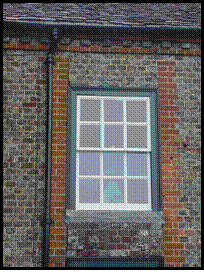
Surveyor: What is a margin light sash?
Charles Brooking :
Margin Lights Defined
A Margin Light is a window with a margin. A strip of glass running around the edge of the frame and then divided up so you have got a border line of glass running around the edge of the frames, as it were. Often that was used as coloured glass within those margins, but in this case they were plain, but they were nicely detailed windows.
Surveyor: Where they acid etched?
Charles Brooking : No, quite plain but we had rescued a front door from there a few weeks before but the demolition started.
There was a little problem, because you could imagine in those days we went down there and chatted the foreman up but he said oh we can't have anyone on site. My tutor took me down there, very dramatic it was, because they were just about to pull down two houses next door to the Robin Hood Pub, well not quite next door but three or four houses up, and they were driving the bulldozer down the hill to demolish the houses and my tutor talked about the emotional psychology of this and the philosophy behind a building like this being torn apart after a century of life, just being pulled over in a few minutes with steel balls hit through the brickwork and the whole thing just collapsed. It was quite a dramatic sight and I was quite moved by it.
The chap on the site said the foreman is a bit of a blighter, you come back tomorrow and I'll let you go around and grab a few bits but not whilst he's on the job because he won't have anyone on the job because of insurance. We were told we can't have anyone looking around, people ask all the time but the boss will not allow it.
The next day my tutor was not free so I got my cycle out and I struggled down to this massive site with huge bonfires burning.
Surveyor: How many houses had been demolished? Are we talking five, ten?

Charles Brooking : Oh gosh that's a good question. We are talking about, I should think it must be getting on for fifty or so at least. I could probably tell you more by looking at an old map. Fifty to sixty houses were going and they were starting from the bottom.
Surveyor: Were they two or three bedroom houses?
Charles Brooking : They were two bedroom, often with a very small bedroom at the back, a little back addition but some were just two.
Surveyor: Terraced or semis?
Charles Brooking : Most of them were terraced but there was a double villa, the one that I was particularly interested in, with the yellow polygramatic bricks set in a red brick around the windows; yellow brick quoins, the rest was red brick built in 1862.

Surveyor: The yellow brick quoins, they are actually bricks on the corner?
Charles Brooking : On the corner of the building and around the windows and doors.
Surveyor: Do they use the term quoins for bricks around the windows?
Charles Brooking : You get brick quoins around the windows yes.
Basically with gauge brick arches above; nicely detailed. So I duly cycled down as I said and there was a massive fire burning, but alas they had torn these houses down. The windows I had wanted were trashed but I did manage to rescue some bits and became aware very quickly of the importance of a sash pulley as a dating method and decided there and then to build up a very comprehensive collection of sash pulleys which is now a major part of the sash window collection.
Surveyor: Please explain the sash pulley?
Charles Brooking :
Sash Pulleys Defined
A sash pulley is basically the little pulley wheel which the sash cord runs over from the sash and is joined to the weight in the sash box and it's mounted into the pulley style with two screws.
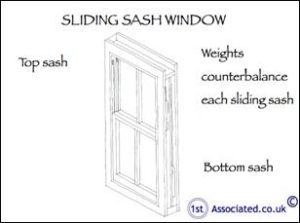
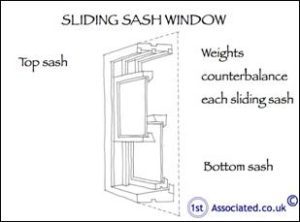
Surveyor: Did the sash pulley have a date when it first started to be used. Did they do sliding sash windows without sash pulleys?
Charles Brooking : Oh yes the earlier ones were just held up with pegs or propped up and then in I believe in the 1670's the idea developed slowly in the Royal Court it's believed.
Surveyor: In France or the British Museum?
Charles Brooking : Well they had vertically sliding sash windows in France in the 17th century but the term sash window is generally applied to windows that are counter balanced. The French joiners came across with the Court, in the 1670's, and they tended to employ timber rather than the wrought iron methods that we had here which were very draughty and a lot of windows apparently were replaced, I think it was Somerset House?
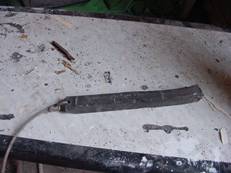
Surveyor: Somerset House, London?
Charles Brooking : Yes I think it was there. I will have to check up on that. Where they replaced the windows it is believed with vertically sliding sashes with a central mullion. They were hanging doors because it was a period of great invention. They had weights, closed doors, they had bird cages which were raised and lowered with a counter balance weight and someone had the bright idea of attaching a lead weight to the sash or one of the sashes and hanging at the side with a pulley wheel or something so that they could hold it up, and that slowly developed it's thought into a boxed frame. There were various mutations and that became the traditional sash window. It was a very in depth study which of course they were working on.
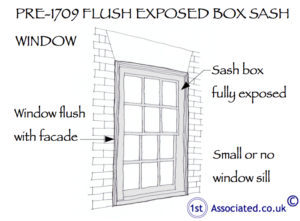
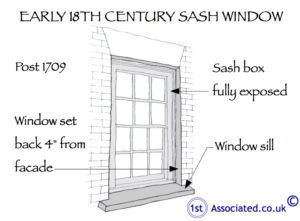
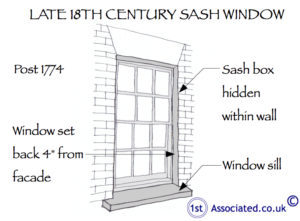
So the pulley wheel was basically a turned brass wheel, rather like a clock wheel or a wooden wheel if it was cheaper, set into the pulley style but as it progressed they made a special case. They were wooden with a case after they were set directly into the pulley style. They made a separate case so you could take the pulley out if it wore out and replace it or whatever and then by the 1730's they had a wrought iron. They were making them with a brass case fixed by screws with the screws hand cut and at that stage rather than turned on a lathe. There was a whole study of the screw making process, which is very interesting and screws were actually filed by hand so the thread was actually filed.
If you found this article on The Brooking Collection of Architectural Detail interesting you may also be interested in the following articles on our website
Sliding sash windows
Buying a property at auction
Structural survey, what does a Surveyor do?
References:
TheBrookingCollection.com DartfordArchive.org.uk IHBC.org.uk ProjectBook.co.uk
Independent Surveyors
If you truly do want an independent expert opinion from a Surveyor with regard to building surveys, structural surveys, structural reports, engineers reports, specific defects report, dilapidations or any other property matters please contact 0800 298 5424 for a Surveyor to give you a call back.
Commercial Property Surveyors
If you have a commercial property, be it leasehold or freehold, then you may wish to look at our Dilapidations Website at www.DilapsHelp.com and for Disputes go to our Disputes Help site www.DisputesHelp.com . We hope you found the article of use and if you have any experiences that you feel should be added to this article that would benefit others, or you feel that some of the information that we have put is wrong then please do not hesitate to contact us (we are only human). The contents of the website are for general information only and is not intended to be relied upon for specific or general decisions. Appropriate independent professional advice should be paid for before making such a decision.
All rights reserved
All rights are reserved the contents of the website are not to be reproduced or transmitted in any form in whole or part without the express written permission of 1stassociated.com

